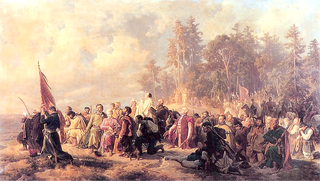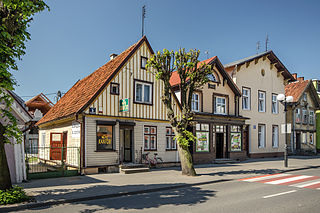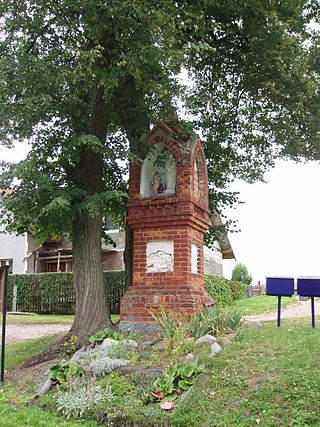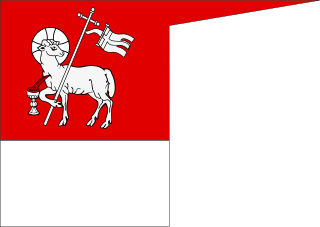
The Partitions of Poland were three partitions of the Polish–Lithuanian Commonwealth that took place toward the end of the 18th century and ended the existence of the state, resulting in the elimination of sovereign Poland and Lithuania for 123 years. The partitions were conducted by the Habsburg monarchy, the Kingdom of Prussia, and the Russian Empire, which divided up the Commonwealth lands among themselves progressively in the process of territorial seizures and annexations.

The Marienwerder Region was a government region (Regierungsbezirk) of Prussia from 1815 until 1920 and again 1939-1945. It was a part of the Province of West Prussia from 1815 to 1829, and again 1878–1920, belonging to the Province of Prussia in the intervening years, and to the Reichsgau Danzig-West Prussia in the years 1939-1945. The regional capital was Marienwerder in West Prussia.

The Bar Confederation was an association of Polish nobles (szlachta) formed at the fortress of Bar in Podolia, now part of Ukraine, in 1768 to defend the internal and external independence of the Polish–Lithuanian Commonwealth against Russian political influence and against King Stanislaus II Augustus with Polish reformers, who were attempting to limit the power of the Commonwealth's wealthy magnates.

Noteć is a river in central Poland with a length of 391 km (243 mi) and a basin area of 17,302 km2 (6,680 sq mi). It is the largest tributary of the Warta river and lies completely within Poland.

The Nogat is a 62 km long delta branch of the Vistula River in northern Poland. Unlike the main river, it does not empty into Gdańsk Bay but rather into the Vistula Lagoon.

Nowy Dwor Gdanski is a town in Poland on the Tuja river in the Żuławy Wiślane region, capital of Nowy Dwór Gdański County, located in Pomeranian Voivodeship, with 10,171 inhabitants (2012).

King in Prussia was a title used by the Prussian kings from 1701 to 1772. Subsequently, they used the title King of Prussia.

Following three consecutive partitions of Poland carried out between 1772 and 1795, the sovereign state known as the Polish–Lithuanian Commonwealth disappeared from the map of Europe. In 1918 following the end of World War I, the territories of the former state re-emerged as the states of Poland and Lithuania among others. In the intervening period, the territory of the former Polish–Lithuanian Commonwealth was split between the Austrian Empire, the Kingdom of Prussia and the Russian Empire. These powers subdivided the territories that they gained and created new toponyms for the territories conquered. The subdivisions created were complicated by changes within those empires as well as by the periodic establishment of other forms of the quasi-Polish provinces led by a foreign head of state.

The Danzig Region was a government region, within the Prussian Provinces of West Prussia and of Prussia. The regional capital was Danzig (Gdańsk). Prussian government regions were not bodies of regional self-rule of the districts and cities comprised, but shear top-to-down government agencies to apply federal or state law and supervise local entities of self-rules, such as municipalities, rural and urban districts.

The First Partition of the Polish-Lithuanian Commonwealth took place in 1772 as the first of three partitions that eventually ended the existence of the Polish–Lithuanian Commonwealth by 1795. The growth of power in the Russian Empire threatened the Kingdom of Prussia and the Habsburg monarchy and was the primary motive behind the First Partition.
Budy is a village in the administrative district of Gmina Jastrowie, within Złotów County, Greater Poland Voivodeship, in west-central Poland. It lies approximately 12 kilometres (7 mi) west of Jastrowie, 27 km (17 mi) west of Złotów, and 112 km (70 mi) north of the regional capital Poznań.

Szymankowo is a village in the administrative district of Gmina Lichnowy, within Malbork County, Pomeranian Voivodeship, in northern Poland. It lies approximately 5 kilometres (3 mi) south of Lichnowy, 9 km (6 mi) north-west of Malbork, and 38 km (24 mi) south-east of the regional capital Gdańsk.
Nowy Przykop is a village in the administrative district of Gmina Purda, within Olsztyn County, Warmian-Masurian Voivodeship, in northern Poland. It lies approximately 12 kilometres (7 mi) south-west of Purda and 17 km (11 mi) south of the regional capital Olsztyn. It is located within historic Warmia.
Pajtuński Młyn is a settlement in the administrative district of Gmina Purda, within Olsztyn County, Warmian-Masurian Voivodeship, in northern Poland. It lies approximately 3 kilometres (2 mi) north-west of Purda and 14 km (9 mi) south-east of the regional capital Olsztyn. It is located within the historic region of Warmia.
Pajtuny is a village in the administrative district of Gmina Purda, within Olsztyn County, Warmian-Masurian Voivodeship, in northern Poland. It lies approximately 3 kilometres (2 mi) north-east of Purda and 16 km (10 mi) east of the regional capital Olsztyn. It is located within the historic region of Warmia.

Szczęsne is a village in the administrative district of Gmina Purda, within Olsztyn County, Warmian-Masurian Voivodeship, in northern Poland. It lies approximately 9 kilometres (6 mi) west of Purda and 8 km (5 mi) south-east of the regional capital Olsztyn. It is located within the historic region of Warmia.

Trękus is a village in the administrative district of Gmina Purda, within Olsztyn County, Warmian-Masurian Voivodeship, in northern Poland. It lies approximately 8 kilometres (5 mi) west of Purda and 10 km (6 mi) south-east of the regional capital Olsztyn. It is located within the historic region of Warmia.
Warniłęg is a village in the administrative district of Gmina Złocieniec, within Drawsko County, West Pomeranian Voivodeship, in north-western Poland. It lies approximately 13 kilometres (8 mi) north-east of Złocieniec, 24 km (15 mi) north-east of Drawsko Pomorskie, and 105 km (65 mi) east of the regional capital Szczecin.

The Prince-Bishopric of Warmia was a semi-independent ecclesiastical state, ruled by the incumbent ordinary of the Warmia see and comprising one third of the then diocesan area. The Warmia see was a Prussian diocese under the jurisdiction of the Archbishopric of Riga that was a protectorate of the Monastic state of the Teutonic Knights (1243–1464) and a protectorate and part of the Kingdom of Poland—later part of the Polish–Lithuanian Commonwealth (1464–1772), confirmed by the Peace of Thorn in 1466. The other two thirds of the diocese were under the secular rule of the Teutonic Knights until 1525 and Ducal Prussia thereafter, both entities also being a protectorate and part of Poland from 1466.














